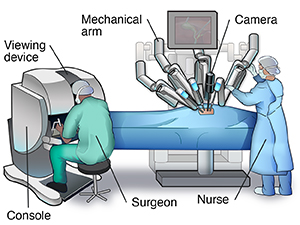Understanding Robotic Surgery
Robotic surgery is a method for surgery that’s done with mechanical arms and a computer. It uses a viewing screen and special tools. It’s also called robot-assisted laparoscopy. Robotic surgery doesn’t mean that a machine does surgery instead of a person. It means that a surgeon uses the robotic tools to do surgery.
What is a robotic surgery system?
A robotic surgery system can include:
-
1 to 4 mechanical arms on a stand that is placed next to the operating table
-
Small surgery tools attached to the ends of the arms
-
A tiny camera and light on one of the arms
-
A separate console with a 3-D viewing device and hand controls for the surgeon
-
Computer technology that connects all of the devices and gives the surgeon control
Why is robotic surgery done?
It’s helpful to know that there are 2 main ways to do surgery:
-
Open surgery. This type of surgery is done with a larger single cut (incision). The incision is larger so that the surgeon can see and work inside the body. The large incision can take longer to heal.
-
Minimally invasive surgery. This is a method that uses 2 or more small incisions. The small incisions often take less time to heal. You may recover from surgery faster. Laparoscopy is a type of minimally invasive surgery. A laparoscope is put through one incision. The scope lets the surgeon see inside the body. Small tools are put through the other incisions. Robotic surgery is a type of minimally invasive surgery.
Robotic surgery has some benefits for surgeons, such as:
-
Robotic tools can make more exact movements. The computer can change the movements of the tools to be smaller or slower than the actual movement of the surgeon’s hands.
-
The tools also move more smoothly. The computer reduces natural hand movement, such as tremor.
-
The surgeon may be seated, leading to less fatigue during longer surgery.
-
The robotic viewing system is in 3-D, instead of 2-D as in regular laparoscopy.
-
Robotic surgery can also be used remotely. A surgeon can be in a different building or part of the country and do surgery. It can also be used for remote training of other surgeons.
But it also has limits. Using this system, a surgeon isn’t in direct contact with your body. They can’t feel the pressure of the tissues of your body during surgery. The robotic system may have a risk of a mechanical problem. It needs extra training. And the surgery costs more. It may not be covered fully by your insurance.
How is robotic surgery done?
You lie on an operating table. A set of robotic arms stand next to the table. The surgeon is seated at a console nearby or in another room. They look into a viewing device. The screen shows 3-D images of the surgery. The surgeon uses hand controls to move the robotic arms. Small surgery tools are attached to the arms. The surgeon uses the hand controls to make small incisions. They then use tools through the small incisions. Nurses stand next to the operating table, watching you and changing tools at the end of the robotic arms as directed by the surgeon.

Kinds of robotic surgery
Robotic tools may be used for many kinds of surgery, including:
-
Gynecology surgery, such as hysterectomy or bladder sling
-
Urology surgery, such as prostate removal
-
Heart surgery, such as mitral valve repair
-
Colorectal surgery, such as removing part or all of the colon or rectum
-
Weight-loss (bariatric) surgery
-
Hernia repair
-
Head and neck surgery
-
Orthopedic surgery, such as joint repair
-
Spine surgery
-
Brain surgery
-
Vascular surgery
Risks and benefits of robotic surgery
Benefits of this kind of surgery include:
Risks include:
-
Longer time in surgery, depending on the training, skill, and experience of the surgeon and team
-
Higher cost of surgery
-
Risk of injury to nearby organs and other tissues, such as the bladder
-
Nerve damage from pressure of the robotic arms
-
Burns and tissue damage
-
Possible mechanical problem with any part of the robotic system
Because the cost of this surgery is higher, your health insurance may not cover a robotic surgery. Or you may pay more out of pocket than with other kinds of surgery.
Talking with your healthcare provider
Before making a decision about robotic surgery:
-
Talk with the surgeon about the procedure. It's important to ask about the risks and benefits for the robotic surgery and the risks and benefits of other approaches. There will be different risks depending on what surgery you need.
-
Ask how many robotic surgeries the surgeon and the team have done. In general, the success of robotic surgery depends on the skill and experience of the surgeon. Surgeons and nurses who do robotic surgery should be trained in using the machine and tools. But there is currently no standard guideline for the type of training or credentials to do robotic surgery. For your own safety, make sure you have a clear sense of the team’s experience in robotic surgery. Ask about the surgeon’s and the team’s robotic training, how many robotic surgeries they have done, the number and types of complications, and any deaths. If the surgeon is reluctant or refuses to discuss your questions, consider going to a different provider.
-
Talk with a second surgeon. You can consult with another surgeon who may do the surgery in a different way. Although robotic surgery does have some short-term benefits, it has fairly similar long-term outcomes when compared with open surgery.
-
Contact your health insurance company. Your insurance company can tell you if the procedure is covered. Also, find out how much you may need to pay out of pocket.